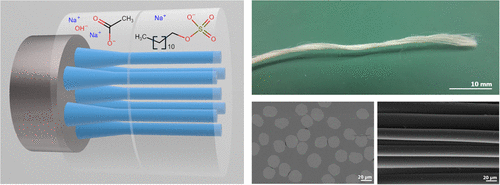当前位置:
X-MOL 学术
›
ACS Appl. Polym. Mater.
›
论文详情
Our official English website, www.x-mol.net, welcomes your feedback! (Note: you will need to create a separate account there.)
Wet Spinning of Chitosan Fibers: Effect of Sodium Dodecyl Sulfate Adsorption and Enhanced Dope Temperature
ACS Applied Polymer Materials ( IF 5 ) Pub Date : 2020-07-29 , DOI: 10.1021/acsapm.0c00562 Oleksandr Nechyporchuk 1 , Ting Yang Nilsson 1 , Hanna Ulmefors 1 , Tobias Köhnke 1
ACS Applied Polymer Materials ( IF 5 ) Pub Date : 2020-07-29 , DOI: 10.1021/acsapm.0c00562 Oleksandr Nechyporchuk 1 , Ting Yang Nilsson 1 , Hanna Ulmefors 1 , Tobias Köhnke 1
Affiliation

|
Production of fibers from nonthermoplastic polymers, such as chitosan, usually requires dissolution with subsequent fiber formation, for instance, via coagulation. Good fiber-forming properties enable simultaneous spinning of multiple fibers into a yarn, which is one of the prerequisites for process scalability. Here, we report a multifilament wet-spinning process that eliminates the use of such volatile organic compounds as methanol and acetone, enhances fiber formation, and allows producing continuous well-separated chitosan fibers after drying. This is achieved by (i) solidification of the extruded solution by alkali and sodium acetate in the coagulation bath and (ii) further stabilization of the fibers by adsorbing the anionic surfactant, sodium dodecyl sulfate. The obtained fibers have a circular cross section and smooth surface. We demonstrate that it is possible to increase fiber breaking tenacity and Young’s modulus by applying stretching (draw ratios up to 1.77) or by incorporating cellulose nanofibrils (CNFs, up to 4 wt % based on chitosan) in the spinning solutions. However, the limitation of increased viscosity when adding CNF is needed to be overcome for possible higher reinforcement effects. We demonstrate that fiber breaking tenacity, Young’s modulus, and elongation at break can be enhanced even further by increasing the spin dope temperature from 22 to 60 °C, with simultaneously increasing the spin dope solid content to keep the same dope viscosity. The fibers with a maximum breaking tenacity of ca. 10 cN/tex at an elongation at break of ca. 7.5% were obtained.
中文翻译:

壳聚糖纤维的湿纺:十二烷基硫酸钠的吸附和浓液温度的提高
由非热塑性聚合物例如壳聚糖生产纤维通常需要溶解并随后形成纤维,例如通过凝结。良好的成纤性能可将多根纤维同时纺成纱线,这是工艺可扩展性的先决条件之一。在这里,我们报道了一种复丝湿纺工艺,该工艺消除了使用挥发性有机化合物(如甲醇和丙酮)的使用,增强了纤维的形成,并允许在干燥后连续生产分离良好的壳聚糖纤维。这是通过(i)在凝固浴中用碱和乙酸钠使挤出溶液固化,以及(ii)通过吸附阴离子表面活性剂十二烷基硫酸钠进一步稳定纤维而实现的。所得纤维具有圆形横截面和光滑的表面。我们证明,通过在纺丝溶液中施加拉伸(拉伸比最高为1.77)或掺入纤维素纳米原纤维(CNFs,基于壳聚糖的含量最高为4 wt%),可以提高纤维的断裂强度和杨氏模量。然而,需要克服添加CNF时粘度增加的限制,以实现更高的增强效果。我们证明,通过将纺丝原液的温度从22升高到60°C,同时增加纺丝原液的固含量以保持相同的纺丝原液粘度,可以进一步提高纤维的断裂韧度,杨氏模量和断裂伸长率。具有最大断裂韧度为ca.的纤维。断裂伸长率为约10cN / tex。获得7.5%。
更新日期:2020-09-11
中文翻译:

壳聚糖纤维的湿纺:十二烷基硫酸钠的吸附和浓液温度的提高
由非热塑性聚合物例如壳聚糖生产纤维通常需要溶解并随后形成纤维,例如通过凝结。良好的成纤性能可将多根纤维同时纺成纱线,这是工艺可扩展性的先决条件之一。在这里,我们报道了一种复丝湿纺工艺,该工艺消除了使用挥发性有机化合物(如甲醇和丙酮)的使用,增强了纤维的形成,并允许在干燥后连续生产分离良好的壳聚糖纤维。这是通过(i)在凝固浴中用碱和乙酸钠使挤出溶液固化,以及(ii)通过吸附阴离子表面活性剂十二烷基硫酸钠进一步稳定纤维而实现的。所得纤维具有圆形横截面和光滑的表面。我们证明,通过在纺丝溶液中施加拉伸(拉伸比最高为1.77)或掺入纤维素纳米原纤维(CNFs,基于壳聚糖的含量最高为4 wt%),可以提高纤维的断裂强度和杨氏模量。然而,需要克服添加CNF时粘度增加的限制,以实现更高的增强效果。我们证明,通过将纺丝原液的温度从22升高到60°C,同时增加纺丝原液的固含量以保持相同的纺丝原液粘度,可以进一步提高纤维的断裂韧度,杨氏模量和断裂伸长率。具有最大断裂韧度为ca.的纤维。断裂伸长率为约10cN / tex。获得7.5%。



























 京公网安备 11010802027423号
京公网安备 11010802027423号